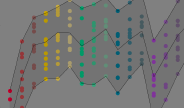
Brilliance and zero grayness (denoted as G0) and are two terms coined by Ralph Evans. Nayatani, Heckaman and Fairchild have done series of work to incorporate them into comprehensive color appearance models. In this work, those concepts were reexamined to scale lightness/brightness across the chromaticity diagram. Specifically, observers, mostly with a color science background, were asked to adjust the luminance of a color patch to appear with no grayness, or equivalently just about/cease to glow. The hypothesis was that lightness can be equalized across those chromaticities and the Helmholtz-Kohlrausch effect is automatically incorporated. This hypothesis was verified in a follow-up experiment where another group of observers completed paired comparisons of the brightness between the collected G0 results. The G0 task was also repeated under another two levels of adaption backgrounds, based on which different absolute brightness results for a given chromaticity might be derived. In addition, high correlations between the G0 results (as a perceptual boundary between appearance modes) and different physical gamut boundaries including MacAdam's optimal colors were found for possible computational proxies and ecologically meaningful implications.